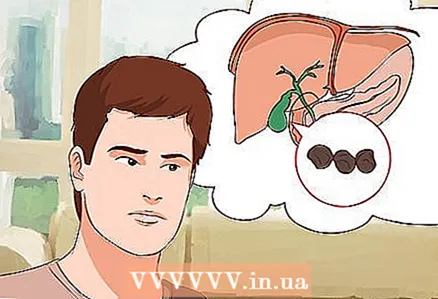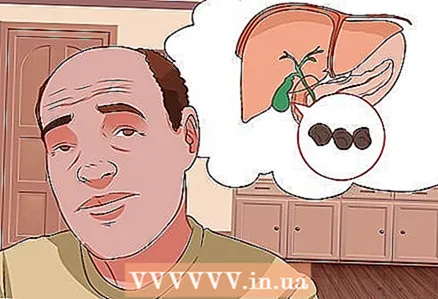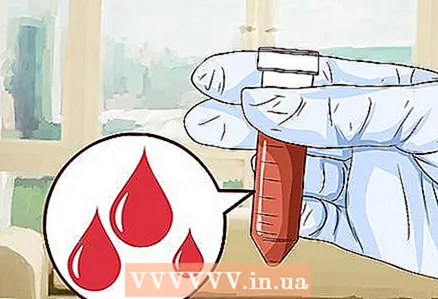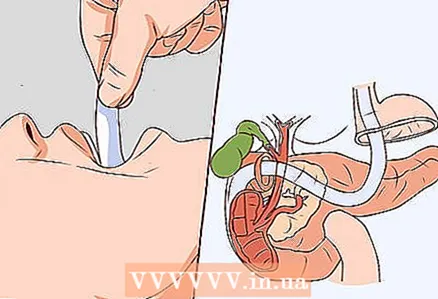
Content
- Steps
- Part 1 of 4: Symptoms of Gallstone Disease
- Part 2 of 4: Risk Factors
- Part 3 of 4: Diagnosing gallstones
- Part 4 of 4: Preventing Gallstone Disease
- Warnings
Gallstones appear in the gallbladder and common bile duct, organs used by the body to carry and deliver digestive enzymes. When there are disorders in and around the gallbladder, stones sometimes form. They can be from a few millimeters to several centimeters in diameter and do not cause any inconvenience. Many factors affect the formation of gallstones, including metabolism, genetic predisposition, immunity, and the environment. To diagnose gallstones, attention should be paid to minor symptoms and certain diseases that lead to the formation of these stones. Nevertheless, for a definitive diagnosis, a consultation with a gastroenterologist is necessary.
Attention:the information in this article is for informational purposes only. Before using any methods, consult your doctor.
Steps
Part 1 of 4: Symptoms of Gallstone Disease
 1 Please note that often gallstone disease is not accompanied by any symptoms. Gallstones can remain for decades without causing pain. For most people, gallstones do not cause any symptoms. In fact, gallstone disease is symptomatic in only 5–10% of patients. This makes it difficult to identify gallstones, and a gastroenterologist should be consulted to make the correct diagnosis.
1 Please note that often gallstone disease is not accompanied by any symptoms. Gallstones can remain for decades without causing pain. For most people, gallstones do not cause any symptoms. In fact, gallstone disease is symptomatic in only 5–10% of patients. This makes it difficult to identify gallstones, and a gastroenterologist should be consulted to make the correct diagnosis. - Less than half of patients with cholelithiasis develop any symptoms.
 2 Watch for possible biliary colic. Gallstones can cause recurring pain in the upper right abdomen (pain in the right upper quadrant of the abdomen) or in the front of the lower sternum (epigastric pain). Gallstone disease can be accompanied by gnawing pain, nausea, and vomiting. This pain, called biliary colic, usually lasts longer than 15 minutes and can sometimes spread to the back.
2 Watch for possible biliary colic. Gallstones can cause recurring pain in the upper right abdomen (pain in the right upper quadrant of the abdomen) or in the front of the lower sternum (epigastric pain). Gallstone disease can be accompanied by gnawing pain, nausea, and vomiting. This pain, called biliary colic, usually lasts longer than 15 minutes and can sometimes spread to the back. - After the first time, patients usually experience recurrent bouts of biliary colic from time to time. After the attack, the pain goes away. Biliary colic may occur only a few times a year.
- It is easy to confuse this symptom with pain in the digestive tract and abdomen caused by other causes.
- If you suspect you have biliary colic, make an appointment with your gastroenterologist.
 3 Pay attention to how you feel after a heavy or fatty meal. See if you are experiencing stomach pain and / or gallbladder cramps after eating a large or fatty meal, such as having a breakfast of bacon and sausage eggs or overeating during the holidays. At such times, pain and / or biliary colic is most likely.
3 Pay attention to how you feel after a heavy or fatty meal. See if you are experiencing stomach pain and / or gallbladder cramps after eating a large or fatty meal, such as having a breakfast of bacon and sausage eggs or overeating during the holidays. At such times, pain and / or biliary colic is most likely. - Some patients experience mild biliary colic without signs of infection and do not require medical attention.
 4 Pay attention to severe abdominal pain that spreads to your back or shoulders. This is the main symptom of gallbladder inflammation, which is often caused by gallstones. Usually, the pain increases with inhalation.
4 Pay attention to severe abdominal pain that spreads to your back or shoulders. This is the main symptom of gallbladder inflammation, which is often caused by gallstones. Usually, the pain increases with inhalation. - In particular, pain is possible between the shoulder blades and in the right shoulder.
 5 Check for a fever. Inflammation of the gallbladder is much more serious than biliary colic, and fever is the main symptom that distinguishes the two symptoms on the basis of their severity. If you suspect you have gallbladder inflammation, you should seek immediate medical attention.
5 Check for a fever. Inflammation of the gallbladder is much more serious than biliary colic, and fever is the main symptom that distinguishes the two symptoms on the basis of their severity. If you suspect you have gallbladder inflammation, you should seek immediate medical attention. - The infection occurs in about 20 percent of patients. Diabetes mellitus increases the risk of infection.
- The infection can cause gangrene and perforation of the gallbladder.
- The fever may be accompanied by jaundice. At the same time, the whites of the eyes and skin turn yellow.
Part 2 of 4: Risk Factors
 1 Consider your age. The risk of developing gallstones increases with age. In fact, the likelihood of developing gallstone disease is greatest when a person is over 60-70 years old.
1 Consider your age. The risk of developing gallstones increases with age. In fact, the likelihood of developing gallstone disease is greatest when a person is over 60-70 years old.  2 Consider your gender. Women are more prone to gallstone disease than men (the ratio is 2-3 to 1). Gallstones form in twenty-five percent of women over the age of 60. This sexual imbalance is due to the presence in the body of the hormone estrogen, which is higher in women. Estrogen stimulates the liver to produce cholesterol, and many gallstones are composed of this substance.
2 Consider your gender. Women are more prone to gallstone disease than men (the ratio is 2-3 to 1). Gallstones form in twenty-five percent of women over the age of 60. This sexual imbalance is due to the presence in the body of the hormone estrogen, which is higher in women. Estrogen stimulates the liver to produce cholesterol, and many gallstones are composed of this substance. - Estrogen increases the likelihood of gallstone formation in women who are taking hormone replacement therapy. Hormone therapy increases the risk of gallstone disease by 2-3 times. Oral contraceptives also increase the likelihood of gallstone formation, as they affect hormone levels in a woman's body.
 3 Consider pregnancy as a risk factor. The likelihood of gallstone formation increases during pregnancy. In addition, pregnant women are more likely to show the symptoms listed above than other women.
3 Consider pregnancy as a risk factor. The likelihood of gallstone formation increases during pregnancy. In addition, pregnant women are more likely to show the symptoms listed above than other women. - If you suspect that you have gallbladder colic or inflammation of the gallbladder, see your gastroenterologist immediately.
- After pregnancy, gallstones can go away on their own without surgery or medication.
 4 Consider genetic markers. High-risk groups include people from Northern Europe and Latin America. Gallstones are very common among some indigenous peoples of America, especially tribes in Peru and Chile.
4 Consider genetic markers. High-risk groups include people from Northern Europe and Latin America. Gallstones are very common among some indigenous peoples of America, especially tribes in Peru and Chile. - Family history also plays a role. The risk of gallstone disease is increased if it has already occurred in your family. However, the results of studies have not yet allowed to come to an unambiguous opinion about this risk factor.
 5 Consider your health and chronic conditions. Consult a gastroenterologist if you have Crohn's disease, cirrhosis of the liver, or any blood disorder, as these conditions increase your risk of gallstones. Organ transplants and prolonged parenteral (intravenous) nutrition can also cause cholelithiasis.
5 Consider your health and chronic conditions. Consult a gastroenterologist if you have Crohn's disease, cirrhosis of the liver, or any blood disorder, as these conditions increase your risk of gallstones. Organ transplants and prolonged parenteral (intravenous) nutrition can also cause cholelithiasis. - The risk of gallstone formation and the development of other gallbladder diseases is also increased in patients with diabetes mellitus. This is due to overweight and obesity.
 6 Keep in mind that lifestyle can also be a risk factor. Obesity and frequent extreme diets have been found to increase the risk of gallstones by 12 to 30 percent.In obese people, the liver makes more cholesterol, and about 20 percent of gallstones are made from it. Generally speaking, frequent weight gain and weight loss can cause gallstones to form. The risk is highest in people who lose more than 24 percent of their weight, as well as those who lose more than a pound and a half per week.
6 Keep in mind that lifestyle can also be a risk factor. Obesity and frequent extreme diets have been found to increase the risk of gallstones by 12 to 30 percent.In obese people, the liver makes more cholesterol, and about 20 percent of gallstones are made from it. Generally speaking, frequent weight gain and weight loss can cause gallstones to form. The risk is highest in people who lose more than 24 percent of their weight, as well as those who lose more than a pound and a half per week. - Among other things, a diet high in fat and cholesterol can contribute to the formation of gallstones from cholesterol (which is the most common and yellow gallstone type).
- An inactive, sedentary lifestyle increases the risk of gallstones.
 7 Note that some medications can contribute to gallstone formation. Taking oral contraceptives at a young age, taking high doses of estrogen for replacement therapy, and chronic use of corticosteroids, cytotoxic drugs, or cholesterol-lowering drugs can increase the risk of gallstones.
7 Note that some medications can contribute to gallstone formation. Taking oral contraceptives at a young age, taking high doses of estrogen for replacement therapy, and chronic use of corticosteroids, cytotoxic drugs, or cholesterol-lowering drugs can increase the risk of gallstones.
Part 3 of 4: Diagnosing gallstones
 1 Get an abdominal ultrasound scan. This is the best way to detect and determine the type of gallstones. Ultrasound examination is painless and allows you to obtain an image of the soft tissues of the abdominal cavity using ultrasound waves. A trained professional will be able to determine if stones are present in the gallbladder or common bile duct.
1 Get an abdominal ultrasound scan. This is the best way to detect and determine the type of gallstones. Ultrasound examination is painless and allows you to obtain an image of the soft tissues of the abdominal cavity using ultrasound waves. A trained professional will be able to determine if stones are present in the gallbladder or common bile duct. - This method can detect gallstones in approximately 97–98% of patients.
- Ultrasound examinations use a pain-free machine that recreates an image of the gallbladder using sound waves reflected from tissues. The operator will lubricate your belly with the gel so that the sound waves penetrate the body better and are more accurately recorded by the device. This painless procedure usually takes 15-30 minutes.
- You should refrain from eating 6 hours or more before the ultrasound examination.
 2 Schedule a computed tomography (CT) scan. If your doctor needs more scans or if the ultrasound is inconclusive, a CT scan may be needed. This method uses X-rays to obtain sectional images of the gallbladder, which are then interpreted by a computer.
2 Schedule a computed tomography (CT) scan. If your doctor needs more scans or if the ultrasound is inconclusive, a CT scan may be needed. This method uses X-rays to obtain sectional images of the gallbladder, which are then interpreted by a computer. - You will be asked to lie down in a cylindrical machine that will scan your body for about 30 minutes. This is a fairly quick and painless procedure.
- In some cases, your gastroenterologist may refer you to MRI (magnetic resonance imaging) rather than CT. In MRI, a similar apparatus is used, which allows you to obtain an accurate image of the internal organs by magnetic vibrations. This procedure lasts up to one hour, and during this time the patient lies in the cylindrical scanning device.
- CT has no advantages over ultrasound, except that it is better at detecting stones in the common bile duct, the small tube through which bile passes from the gallbladder to the intestines.
 3 Get a blood test. If you suspect you may have an infection in your abdomen, a complete blood count may be done. This test will detect a serious gallbladder infection and determine if surgery is needed. In addition to infection, blood tests can help detect other complications of gallstone disease, including jaundice and pancreatitis.
3 Get a blood test. If you suspect you may have an infection in your abdomen, a complete blood count may be done. This test will detect a serious gallbladder infection and determine if surgery is needed. In addition to infection, blood tests can help detect other complications of gallstone disease, including jaundice and pancreatitis. - This is a standard blood test. The doctor or nurse will draw blood from a vein using a fine needle and place it in small tubes for further laboratory analysis. The results of the analysis will allow the gastroenterologist to judge your condition.
- Leukocytosis and elevated C-reactive protein levels are signs of acute cholecystitis, an inflammation of the gallbladder that can be caused by gallstones. The gastroenterologist may pay attention to these characteristics along with the standard electrolyte content and other parameters.
 4 Get retrograde cholangiopancreatography (RCPG). A gastroenterologist may prescribe RCP, which is an invasive procedure that inserts a flexible, finger-thick tube into the digestive tract through the mouth to examine the walls of the stomach and intestines. If the doctor finds gallstones during this procedure, they can remove them.
4 Get retrograde cholangiopancreatography (RCPG). A gastroenterologist may prescribe RCP, which is an invasive procedure that inserts a flexible, finger-thick tube into the digestive tract through the mouth to examine the walls of the stomach and intestines. If the doctor finds gallstones during this procedure, they can remove them. - Tell your doctor about any medication you are taking, especially if you are taking insulin, acetylsalicylic acid (aspirin), blood pressure pills, warfarin, or heparin. These drugs can cause bleeding during some procedures, and it is possible that the doctor will ask you to temporarily not take them.
- Because the procedure is invasive, you will be given medication that may make you drowsy. It is also advisable to have someone accompany you who can take you home after the procedure.
 5 Rule out the possibility of gallstones with liver function tests (LFTs). If your doctor has already ordered tests to check if you have cirrhosis or other liver disease, they can simultaneously identify possible gallbladder problems.
5 Rule out the possibility of gallstones with liver function tests (LFTs). If your doctor has already ordered tests to check if you have cirrhosis or other liver disease, they can simultaneously identify possible gallbladder problems. - FPP may be required along with a blood test to further confirm the presence of gallstones.
- Your doctor will check your bilirubin, gamma glutamyl transferase (GGT), and alkaline phosphatase levels. An increased concentration of these substances may indicate gallstones or other gallbladder problems.
Part 4 of 4: Preventing Gallstone Disease
 1 Lose weight slowly. If you want to lose weight, don't go on extreme diets. Try to eat healthy, well-balanced foods and include plenty of vegetables and fruits, complex carbohydrates (such as whole wheat bread and pasta, brown rice), and protein in your diet. You should lose no more than 0.5-1 kilograms per week.
1 Lose weight slowly. If you want to lose weight, don't go on extreme diets. Try to eat healthy, well-balanced foods and include plenty of vegetables and fruits, complex carbohydrates (such as whole wheat bread and pasta, brown rice), and protein in your diet. You should lose no more than 0.5-1 kilograms per week. - Gradual and gradual weight loss reduces the risk of gallstone formation.
 2 Reduce your intake of animal fats. Butter, meat and cheese raise cholesterol levels and increase the risk of gallstone disease. Elevated levels of fat and cholesterol contribute to the formation of gallstones - cholesterol stones are most commonly found in the gallbladder.
2 Reduce your intake of animal fats. Butter, meat and cheese raise cholesterol levels and increase the risk of gallstone disease. Elevated levels of fat and cholesterol contribute to the formation of gallstones - cholesterol stones are most commonly found in the gallbladder. - Eat monounsaturated fat instead. These fats increase the level of "good" cholesterol, which reduces the risk of gallstones. Instead of saturated animal fats such as butter and lard, use olive oil and sunflower oil. The risk of developing gallstone disease is also lowered by omega-3 fatty acids, which are found in rapeseed and flaxseed oils and fish oils.
- Nuts are also found to contain healthy fats, and some studies have shown that the risk of gallstones can be reduced by eating peanuts and other nuts such as walnuts and almonds.
 3 Eat 20 to 35 grams of fiber daily. Dietary fiber reduces the risk of developing gallstone disease. They are rich in legumes, nuts and seeds, fruits and vegetables, and whole grain foods. You can usually get enough fiber from food.
3 Eat 20 to 35 grams of fiber daily. Dietary fiber reduces the risk of developing gallstone disease. They are rich in legumes, nuts and seeds, fruits and vegetables, and whole grain foods. You can usually get enough fiber from food. - However, you can also take dietary fiber supplements such as flaxseed flour. Just mix a heaping teaspoon of flaxseed flour in a glass (250 milliliters) of apple juice.
 4 Choose carbohydrate foods carefully. Sugar, pasta, and bread can all contribute to the formation of gallstones. Eat more whole grains, vegetables, and fruits to reduce the chances of gallstones and make it easier to clear gallstones.
4 Choose carbohydrate foods carefully. Sugar, pasta, and bread can all contribute to the formation of gallstones. Eat more whole grains, vegetables, and fruits to reduce the chances of gallstones and make it easier to clear gallstones. - Several studies have shown that high carbohydrate intake may contribute to the formation of gallstones. This is because carbohydrates are converted into sugar in the body.
 5 Drink coffee and alcohol in moderation. According to some studies, daily coffee consumption and moderate alcohol consumption (no more than 1-2 servings per day) can reduce the risk of gallstone disease. One serving of alcohol equals 350 milliliters of beer, 150 milliliters of wine, or 40 milliliters of spirits.
5 Drink coffee and alcohol in moderation. According to some studies, daily coffee consumption and moderate alcohol consumption (no more than 1-2 servings per day) can reduce the risk of gallstone disease. One serving of alcohol equals 350 milliliters of beer, 150 milliliters of wine, or 40 milliliters of spirits. - The caffeine in coffee stimulates the contraction of the gallbladder and lowers the concentration of cholesterol in the bile. However, according to research, other caffeinated beverages such as tea or Coca-Cola do not seem to have this effect.
- Studies have shown that drinking at least 30 grams of alcohol daily can reduce the risk of gallstones in some people by 20%.
Warnings
- Don't assume that stomach pain is necessarily caused by gallstones or other gallbladder problems. There are many other possible causes of abdominal pain, such as irritable bowel syndrome (IBS), ulcerative colitis, pneumonia, appendicitis, acid reflux, urinary tract infection, diverticulitis, and heart disease. Seek medical attention if you have severe abdominal pain.



